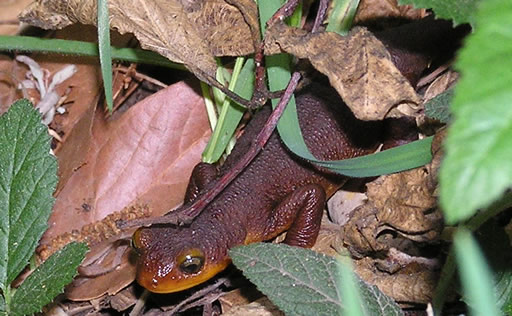Please see Part I of this article for background information on substrate and food related intestinal impactions, including some interesting stories from the field.
Substrates for Aquatic Animals
 Surinam toads, mata-mata turtles, axolotls, mudpuppies and other wide-mouthed aquatic animals that utilize suction (the flow of water into the gaping mouth) to capture prey quite frequently swallow gravel in the course of feeding.
Surinam toads, mata-mata turtles, axolotls, mudpuppies and other wide-mouthed aquatic animals that utilize suction (the flow of water into the gaping mouth) to capture prey quite frequently swallow gravel in the course of feeding.
If you do not care for the look of a bare-bottomed aquarium, our life-like Cypress Mat is well worth considering as a bottom-covering. It cannot be swallowed, is easily rinsed, and many animals will nestle down into it as a shelter. I suggest leaving a bit of the aquarium’s bottom uncovered by the mat until you can determine where your animals prefer to remain.
Sinking driftwood and Mopani wood are also safe to use, and will go a long way in improving your aquarium’s appearance.
Shelters for Burrowing and Aquatic Animals
Artificial and wood-based caves and hideaways are often accepted as substitute shelters by burrowing animals; plastic models are fine for use in aquariums as well. If so inclined, you might also enjoy using novelty decorations and shelters for pets prone to ingesting gravel and sand.
Cork bark pieces and rolls make fine shelters for terrestrial herps, and may be wedged against the aquarium’s sides to form an underwater retreat as well.
Hagen Silk Plants are an excellent option for African bullfrogs, marine toads and other large animals that prefer to back into vegetation or moss as opposed to using a cave. These plants are equipped with suction cups, and when arranged to hang down to the terrarium’s floor they provide a naturalistic retreat. They can be used in a similar fashion under water – Surinam toads in particular prefer this arrangement to a cave.
Tong-Feeding and Separate Feeding Enclosures
Training your pets to feed from tongs will also go a long way in avoiding substrate-swallowing problems. Use plastic tongs for animals with a vigorous feeding response and reserve metal tongs for those that feed gingerly or accept large food items.
Well-acclimated reptiles and amphibians often feed eagerly even after being transported to a separate feeding container. Transferring such animals to a bare-bottomed plastic terrarium or similar enclosure is a useful feeding option.
Further Reading
The Manuel of Exotic Pet Practice’s entry on intestinal impactions is posted here.
 That Reptile Blog – Reptile, Amphibian and Exotic Pet Care and Information
That Reptile Blog – Reptile, Amphibian and Exotic Pet Care and Information

 Live mealworms, waxworms or earthworms mixed into canned or pelleted food should encourage your turtle to take a bite. Earthworms are a box turtle favorite and a highly nutritious food in their own right…they can comprise 25% or so of the diet. An occasional pre-killed pink mouse is usually a great hit with box turtles, but is not a necessity.
Live mealworms, waxworms or earthworms mixed into canned or pelleted food should encourage your turtle to take a bite. Earthworms are a box turtle favorite and a highly nutritious food in their own right…they can comprise 25% or so of the diet. An occasional pre-killed pink mouse is usually a great hit with box turtles, but is not a necessity. Over 200 compounds, some of which are medically significant, have been isolated from newt and salamander skins. Western North America’s rough-skinned newt (Taricha granulosa) possesses what may very well be the salamander world’s most powerful secretions…a single adult packs enough to kill 25,000 mice. More than one person (usually male, drunk and involved in some sort of “initiation” or dare), has suffered fatal consequences after swallowing a rough-skinned newt.
Over 200 compounds, some of which are medically significant, have been isolated from newt and salamander skins. Western North America’s rough-skinned newt (Taricha granulosa) possesses what may very well be the salamander world’s most powerful secretions…a single adult packs enough to kill 25,000 mice. More than one person (usually male, drunk and involved in some sort of “initiation” or dare), has suffered fatal consequences after swallowing a rough-skinned newt. Although the California newt’s (Taricha torosa) toxins pale in comparison to those of its rough-skinned cousin, they are not to be trifled with. I kept a California newt with an American eel for 17 years. The eel, a voracious predator that would as soon latch onto my hand as anything else, never once molested its seemingly defenseless tank-mate.
Although the California newt’s (Taricha torosa) toxins pale in comparison to those of its rough-skinned cousin, they are not to be trifled with. I kept a California newt with an American eel for 17 years. The eel, a voracious predator that would as soon latch onto my hand as anything else, never once molested its seemingly defenseless tank-mate.